
The Landhaus Klagenfurt (lit. 'Klagenfurt Country House') located between Heiligengeistplatz and Alter Platz on the edge of the oldest part of downtown Klagenfurt, Austria, is a historically significant secular building in the Carinthian capital of Klagenfurt. It was built between 1574 and 1594 as part of the city's expansion and fortification efforts, commissioned by the Carinthian Landstand. Today, the Landhaus remains a symbol of Carinthian history and tradition and serves as the seat of the Carinthian state parliament.
Historical background
During the late 15th and early 16th centuries, Carinthia found itself largely left to its own devices. The Habsburg princes, who resided as emperors in Vienna or Prague, were largely absent from the region. Instead, the burden of dealing with Ottoman incursions and uprisings fell upon the Landstände, which represented the nobility and high clergy. In 1478, the Carinthian peasant uprising arose in opposition to new taxes. Further rebellions emerged from Carniola and southern Styria in 1515, eventually leading to the occupation of Althofen and St. Vitus, which served as the capital of Carinthia at that time.

Despite the initial suppression of the uprisings through military intervention, these events bolstered the determination of the "honorable landscape" to establish a seat of power under their own control, rather than being subject to foreign rulers. They selected the city of Klagenfurt, which had suffered extensive damage from a fire in 1514, and petitioned Emperor Maximilian I to relinquish control of the city to them. Given that the imperial court and the city lacked the necessary funds for reconstruction, Maximilian granted ownership to the affluent local nobility in 1518. Over the course of the 16th century, the Landstände oversaw the reconstruction and fortification of the city, ultimately designating Klagenfurt as the new capital of Carinthia.
As early as 1527, the 4.5-kilometer-long Lend Canal was laid, which supplied the city with water from Lake Wörthersee, fed the city moat that had been dug from 1534, and served as a transport route for building materials for the new buildings. The expansion of the city itself began in 1534. Within the newly erected city wall, buildings were built south of the old city center that still characterizes Klagenfurt's face today. The Evangelical Preacher Church (later the Klagenfurt Cathedral) was built in 1581, the Lindwurm fountain was erected on the Neuer Platz in 1593, and the country house was built between 1574 and 1594, which was to serve as the seat of the Landstände.
History
Preceding buildings in the late Middle Ages
Klagenfurt, which was established at its current location in 1246, was granted city rights in 1252. However, during the late Middle Ages, the towns of St. Veit and Völkermarkt held greater importance as sovereign residences in Carinthia. Despite this, records indicate that a castle was built in Klagenfurt during the town's reconstruction period. Castellans of Klagenfurt were mentioned in the year 1258, and a document by Duke Ulrich III's from 1268 refers to a castle.[1] However, little is known about the size and location of this castle, although it is believed to have been situated at the western end of the Alter Platz. Neither the Spanheimer dukes in the 13th century nor the Habsburg sovereigns, who gained possession of the Duchy of Carinthia in 1335, used the castle complex as a seat of power. While the former resided in St. Veit, none of the latter took up permanent residence in Klagenfurt.
In 1489, the citizens of Klagenfurt received the first castle as a gift from the emperor. At that time, a second sovereign castle already existed, which was built during the 15th century. The precise location of this second building is not documented, but it was situated near the older castle, and at least part of it occupied the area where the Landhaus now stands.
Construction of the Landhaus (1574–1594)
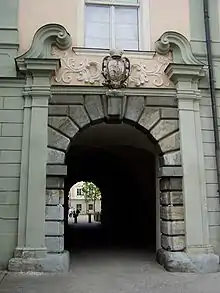
The landhaus was to replace the old sovereign castle, which was destroyed in a city fire in 1535 but had already become dilapidated beforehand. To prepare for the construction of a new building, the Landstände began building an armory in 1518, the foundations of which can still be seen in the northeastern corner of the cellar. It was ultimately decided to build a new castle in 1574 to replace the old one.
On March 3, 1574, Hans Freymann from Bleiburg, who served as the regional master builder and chief armorer, received instructions to construct the new castle and oversee the fortification of the entire city. The precise extent of his involvement in the planning and design of the complex remains unclear, and it is no longer possible to determine his specific contributions to the current structure.[2] However, it is believed that he extended an older, square building located at the northwest corner of the Landhaus by adding a hook-shaped wing that extended towards the south. This new section encompassed a hall (now known as the Grosser Wappensaal) situated above the basement, the Landstube (currently utilized as a meeting room), and several additional rooms adjoining it to the east. These rooms roughly correspond to the present west and south wings of the building.[3]
Before the end of his tenure, the buildings had been completed to such an extent that artistic decoration could begin. After the completion of this first phase of construction at the end of 1580, the Landstände also acquired the so-called Paradeiserhaus in the immediate vicinity (today Landhaushof No. 3), which has since formed a structural and functional ensemble with the Landhaus.

Freymann was replaced as master builder in 1581. It is unclear why. Since the autumn of 1580, there is no longer any evidence of his activity; he may have died in the meantime. His successor Johann Anton Verda, who had previously worked as a stonemason at the Graz Landhaus, played a crucial role in shaping the Landhaus's exterior appearance. He extended the building into a horseshoe shape, added the two-story arcade and accompanying flights of stairs, and built the southern tower. The Diet first met in the Landhaus on 4 December 1581, although the building had already been completed to a great extent. The Landhaus courtyard gate, which closed off the courtyard between the Landhaus and the building complex "Zur goldenen Gans," was the final point of construction and was completed in 1594.
Inside, the Great Coat of Arms Hall had already been completed in 1578 by the Villach landscape painter Anton Blumenthal, who shortly afterward also contributed 47 portraits of the Carinthian princes. In 1587 and 1588, the building was completed under the leadership of Christoph Windisch, with important work also being carried out by the sculptor Ulrich Vogelsang.
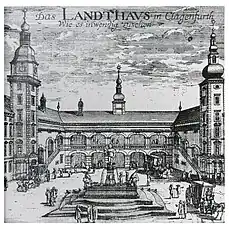
The completed country house is depicted in a contemporary account by Urban Paumgartner, a teacher at the Protestant landscape school "Collegium sapientiae et pietatis" in Klagenfurt. While in exile in Lauingen in 1605, Paumgartner composed the epic Aristeion Carinthiae Claudiforum, consisting of 1000 Latin hexameters. This work describes the newly built city of Klagenfurt in 18 sections and includes a city map, among other illustrations. The Aristeion provides insights about the country house, stating:[4]
I now want to describe the country house, it looks wonderful
By two towers rising to thinner airs
Look down on the entrance with the gates open twice.
Adorned with the art of appeal shines the panel,
and the screed of the hall shimmers with dug fields
marble, the princes shine painted in golden ceilings
Austria, like the estates of these heroes, the capital
Received as a gift and confess with a grateful heart, That they owe to them every reward for virtue. [...]
Now the ground floor, supported on mighty pillars,
Allow me to explore, hidden inside
Brave Marvor's ore-guns rest.
Steel that conquers diamond in hardness, and wings of iron
Form the gate, it glares all around from mighty weapons. [...]
Use and importance from the year 1581
The construction of the city fortifications in 1591 and the Landhaus in 1594 marked a turning point for Klagenfurt, as the city became an important residence for the Landstände both structurally and politically. The completion of the Landhaus also coincided with the establishment of a Carinthian provincial table in 1591, which redefined the group of people in the Landstände and led to the establishment of provincial authorities.
The Landhaus fulfilled a variety of functions, first and foremost it was the meeting place of the Landstände and their committees. In addition, the interrogations of the provincial governors and the "Landschrannengericht" (provincial law and court taiding) also took place in its representative rooms. However, it was the venue for ceremonies, for example, one of the first festive events was a banquet for Archduke Ferdinand II on 27 January 1597, after his hereditary homage. Paumgartner had already reported on dances held by the Landstände, and the Landhaus was also popular for holding wedding receptions for the Landstände. The mint of St. Vitus, which had already been leased in 1529, was also transferred by the Landstände to their new capital. However, they were deprived of the right to mint coins in 1622 and ordered to vacate the mint adjacent to the Landhaus. Parts of the Landhaus were also rented out shortly after its completion as storage rooms, among other things for grain.
However, the Counter-Reformation resulted in the re-Catholicisation of Carinthian towns, especially Klagenfurt (1600 and 1604), and with the expulsion of the Protestant nobility in 1628, provincial centralism finally prevailed, and the activities of the provincial parliament were limited to confirming provincial demands.
Fire and redesign from 1723

On August 16, 1723, a devastating fire broke out in Klagenfurt, causing extensive damage to the Landhaus. In the years following the fire, the building was renovated in the late Baroque style. The south and west façades were adorned with giant pilasters and stucco-decorated window frames. The south tower received two new bells in 1724, which survived both World Wars. In 1735, Ferdinand Fromiller was commissioned to redesign the Great Hall of Arms, which remained the "binding matriculation of Carinthia's Landstände" until 1848.[5] Fromiller added a marble floor in a three-color geometric pattern, as well as the main portal and two fireplaces while painting the coats of arms of the burgraves, councilors, and councilors in the Small Hall of Arms, which served as the council chamber for the councilors. Fromiller painted the coats of arms of the burgraves, councilors, and councilors in the Small Hall of Arms, which was then the council chamber of the councilors.
Use in the 18th and 19th centuries
The banqueting halls, especially the Great Hall of Arms, were used mainly for festivities in the late 18th century, such as the visit of Amalia of Parma in June 1783 and Archduke Ferdinand of Milan in 1786.
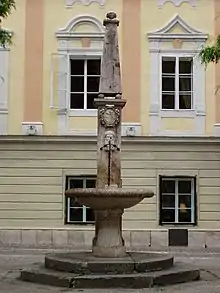
The Napoleonic Wars brought an end to the armory of the Landstände in the Landhaus. However, weapons of the Landwehr were later stored in the rooms. During the French occupation of Klagenfurt in 1809 and 1810, the Landhaus served as a military hospital and suffered severe structural damage.
In 1818, a bust of Emperor Franz I was installed in the Large Hall of Coats of Arms. However, in 1870, it was replaced by the Fürstenstein. Another notable addition is the obelisk fountain, which was constructed by Christophoro Cragnolini in 1833 within the Landhaushof. The fountain was commissioned at a cost of 600 guilders and remains present to this day. In 1843, the country house garden, previously utilized as a vegetable garden, underwent a transformation and was converted into a park. As part of this renovation, the surrounding walls were removed.
Until 1883, the country house also served as the home of the state museum, which later relocated to the Rudolfinum, now known as the Carinthian State Museum. Beginning in 1844, the Historical Association's Museum found its place within the country house, followed by the Natural History Museum in 1861. A monument hall, situated in front of the north wing, housed various significant exhibits. However, in 1882, as part of a renovation project for the Landhaushof, the monument hall was removed.
In 1896, the recently established state mortgage bank found its home on the ground floor of the country house, where it remained for a period of three years. By 1914, the country house accommodated several institutions, including the offices of the state parliament and state committee, the state building authority, the state accounting department, and the state treasury. These governmental bodies were all located within the premises of the country house during that time.
First Republic
In 1926, a Landhaus cellar was established by a government decision. The murals adorning the cellar were created by local Carinthian artists, including Eduard Manhart's "Ankogel," Switbert Lobisser's "Kirchgang," "Keusche am Berg," and "Kärntnerhimmel," Josef Prokop's "Schimmelreiten im Gurktal," and Richard Knaus's "Stern- oder Dreikönigssingen in Paternion" and "Bandltanz." Sadly, all of the paintings, except for Lobisser's "Carinthian Sky," were lost in a fire in 1949 and during renovations in 1969.
In 1924 and 1925, there was an invitation for tenders for the decoration of the meeting hall with the theme of the referendum in 1920, from which Switbert Lobisser emerged as the winner. In 1928, he painted a fresco on the north side in the spirit of the Heimatschutz movement (see description below).[6]
In 1929, Anton Kolig was commissioned to design the Kolig Hall, which is named after him to this day. Between October 1929 and October 1930, Kolig and his students, including Anton Mahringer, painted frescoes in the hall with financial support from the state of Hesse-Nassau. The underlying concept of the frescoes was the idea of fraternization between Austria and Germany. The themes depicted in the frescoes included the military, crafts, hospitality, and patriarchal order, which were considered "quite contemporary" at the time.[7]
The frescoes were executed using colored mortar with applied overpainting in wax casein colors. They deliberately avoided creating an illusion of three-dimensional space and were intentionally left incomplete in appearance. The larger-than-life figures portrayed in the relatively small space appeared somewhat unnatural. While the work was still in progress, there were expressions of dissatisfaction, particularly from the Christian Social Party, and some individual images were met with strong criticism.[8]
Otto Demus, an employee of the Office for the Protection of Monuments, and the Social-Democratic provincial councilor Zeinitzer defended the work. However, in November 1930, members of the National Socialists and the Heimatblock requested the removal of the frescoes in the state parliament. During the state parliament session on March 25, 1931, the proposal to remove the frescoes was narrowly rejected by a vote of 17 to 16. Emmerich Angerer from the Heimatblock stated during the debate, "A people who have fought for their freedom, a people who have sealed their true love of their homeland with their blood, cannot tolerate that even for one or two more days these frescoes, which really offend the people, are exposed to the public."[9]
The Era of National Socialism
The frescoes were imposed before Austria's annexation to the German Reich, the exact date is unknown. When the National Socialists came to power, the frescoes' existence was endangered. In a letter dated 12 October 1938, the provincial curator Walter Frodl wrote that he could not guarantee the safety of the frescoes because "their removal was being demanded from all sides". During the renovation work in the Landhaus in the winter of 1938/39, the frescoes were knocked down; the author and exact date are not known, but it is likely that the time was between November 1938 and February 1939.[10]
In the summer of 1938, Switbert Lobisser had been commissioned by the Minister of the Interior, Wilhelm Frick, to paint frescoes in the conference hall worth 10,000 Reichsmark, entitled "Carinthia's Homecoming into the Reich".[11] At the same time, the Landhaus received a new façade with Terranova spray plaster in the colors ivory, rust red, and grey. The north tower was given a sundial fresco by Otto Bestereimer and Kurt Weiss, showing the zodiac, the runes for life and death, and the saying “Es sollen die Schlechten die Guten nit knechten” (an allusion to the time of illegality).
After the renovation work, the Landhaus became the seat of the Gauleitung of Carinthia at the beginning of 1940. The Koligsaal became the office of Gauleiter Friedrich Rainer.
The country house survived the Second World War without direct bomb hits, but the façade and the roof were severely damaged.
On the first day of May 1945, the Landhaus played a significant role in the re-establishment of democracy in Carinthia. Even before the arrival of British troops, the Democratic parties took over power in the Landtag in early May 1945. Gauhauptmann Natmeßnig and representatives of the Democratic parties held their first meeting here on May 5, and on the morning of May 6, they formed an enforcement committee that moved to adjacent Tabakamt buildings. On the evening of May 7, the provisional provincial government was constituted in the small armorial hall, marking a crucial moment in the restoration of democracy in Carinthia. In 1985, a commemorative plaque was erected in the Landhaus to honor this historic event, bearing the inscription: "In this building / Carinthian / patriots restored / democracy / in the country by / their own efforts on 7 May / 1945."
Second Republic
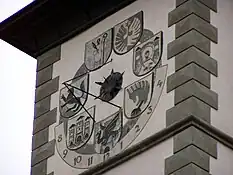
After the end of the Second World War, the Landhaus was confiscated by the British occupying forces, who had the Lobisser frescoes painted over in 1938. It was not until 22 July 1948 that the Landtag was able to meet again in the conference hall.
The country house was extensively renovated between 1964 and 1976. The roof and façades, which had only been repaired in a makeshift fashion after 1945, were renewed. In the inner courtyard, the façade was given its current Renaissance style in grey and white. In 1967 Karl Bauer designed a new sundial on the north tower as a sgraffito with the coats of arms of the - at that time - seven district capitals. In 1970, the meeting hall was redesigned, the visitors' gallery was installed on the east wall and a 350-kilogram coat of arms of Carinthia made of bronze by Werner Lösser was mounted. Oil paintings by Anton Kolig were hung in the Kolig Hall. In 1975/ and 1976, the Great Coat of Arms Hall was restored.
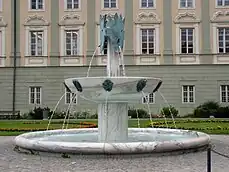
In 1997, the Provincial Archives moved to a new building in St. Ruprechter Straße. Afterward, the Landhaus was again redesigned and renovated. The conference hall was redesigned with new benches, and the bronze coat of arms was replaced by a modern Carinthian graphic. During the renovation work, the so-called Nazi frescoes reappeared. After some discussion, the frescoes were removed from the wall and conserved.
As early as the autumn of 1996, the state parliament had asked the state government to develop a project for the design of the Kolig Hall.[12] The cultural committee and the advisory board for the fine arts spoke out in favor of Cornelius Kolig, the grandson of Anton Kolig because he was in possession of his grandfather's documents and was also an "ostracised artist". Dr. Michael Ausserwinkler, the deputy provincial governor responsible for culture at the time, took over this proposal and said: "I am concerned with a conscious confrontation with the brown spirit in Carinthia's past. I want the MPs to be confronted with this every time before the session begins.[13]"Campaigns against the award to Cornelius Kolig ensued. For example, the Kärntner Krone, the Carinthian edition of the Kronen Zeitung, ran the following headline on 16 March 1998: "Faecal artist to collect millions: Stop cultural scandal in Carinthia!"[14]
At the instigation of the FPÖ, the Cultural Committee decided on 17 March 1998 to invite tenders for the design of the space. The five-member international jury was nominated by the parties in the provincial parliament, and the parties agreed to accept the jury's vote.[15] On 2 July 1998, Cornelius Kolig was unanimously announced as the winner by the jury from among the 19 participants. On 7 July the provincial government decided to award the contract to Kolig with the votes of the ÖVP and SPÖ: "The result does not fit the FPÖ's political worldview. However, we will not let Carinthia become the Punch and Judy of a united Europe." If critics had initially taken offense at the way the contract was awarded, the campaign by the Kärntner Krone and the FPÖ against Cornelius Kolig continued even after the tender they had called for.[16]
In August 1998, construction work on the hall began. At the same time, the FPÖ collected signatures against the project. However, the Klagenfurt Regional Court banned the distribution of the FPÖ leaflet by injunction, as it placed Kolig in the vicinity of child abuse.[17]
Based on these campaigns, Kolig completed the design of the room and added the lettering "TAT ORT", among other things as an allusion to the room's use as Friedrich Rainer's office. On 25 September 1998, the room was presented to the public. On this occasion, Bishop Egon Kapellari and Superintendent Joachim Rathke also testified to the artist's solidarity. Since then, the room has become more of a tourist attraction than a scandal.
Building Specification
Exterior architecture
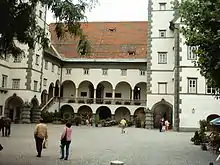
Although planned as a castle, the horseshoe-shaped ground plan of the country house makes it look more like a castle today. On the west and south sides, the building appears very impressive and enclosed; of the original two rustic portals on the west side, one has been bricked up. Through the only portal, one now enters the courtyard of the country house, which has wide staircases on the north and south sides that lead up to the arcade and the Great Hall of Heraldry. Especially here in the courtyard, as often in the city of Klagenfurt am Wörthersee, chlorite slate stone from the nearby Kreuzbergl can be found, for example in the Lindwurm. On the east side, the courtyard is open; the opposite building of the former salt office housed the hotel of the same name.
_20060603.jpg.webp)
The castle-like building does not conform to any classical rule of architecture, for the portal is not placed centrally on the west side, nor is the entrance to the coat of arms hall, and the towers are differently designed. Moreover, the arcades of the staircases "butt up" against the tower walls. But this seems to be precisely the building's special charm, which is why Wilhelm Pinder called the Landhaus one of the proudest post-medieval urban buildings in the German-speaking world.
A curious detail in the Landhaushof is a small stone staircase that was originally used to make it easier to climb on the horses and has been preserved to this day. In 1998, a controversial monument to the "Site of Carinthian Unity" was erected in the Landhaushof. South of the Landhaus, in the adjacent park, is a fountain designed by Kiki Kogelnik called Der Gesang.
Interior design
The Great Hall of Coats of Arms
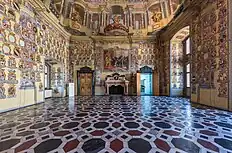
The Great Armorial Hall is located on the first floor of the west wing. It extends over both upper floors and is 9.8 meters high. The floor space measures 23 × 13 meters, and the dimensions of the hall have remained unchanged since 1581. The hall originally had frescoes and a ceiling painting by Anton Blumenthal, but these were destroyed in a fire in 1723. The walls and ceiling of the hall were then redesigned by Josef Ferdinand Fromiller, and since then only individual coats of arms have been added.[18]
On the ceiling is a fresco by Fromiller. The ceiling mirror is framed by an "excellently constructed mock architecture in terms of perspective". The all-around portico with niches in the corners represents. In the niches are Grisailla statues of the Habsburg rulers Matthias, Ferdinand II, III, and IV. The cardinal virtues are depicted in balustrades in the center of each side. No sky opens above the mock architecture, but the hereditary homage of Emperor Charles VI is depicted. This had taken place on 22 August 1728 in the then Palais Rosenberg, now the town hall of Klagenfurt. However, Fromiller architecturally relocated it to the Great Hall of Heraldry. The emperor sits under a red canopy and is surrounded by the deputies, the ecclesiastical dignitaries, the duke's farmer, and the holders of the eleven provincial offices. The coats of arms of the latter as well as the coats of arms of Austria, Carinthia, and the ecclesiastical territories of Salzburg and Bamberg at the edge of the picture connect the homage scene with the mock architecture.
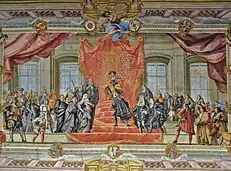
On the north wall, there is a fresco framed as a panel painting dated 1740. It shows the investiture of the Carinthian duke at Fürstenstein near Karnburg. On the south wall is a fresco of the same size showing the handing over of the Gabbrief ( the deed of donation) by Maximilian I to the Carinthian Landstände (24 April 1518), with which Klagenfurt became a provincial city. These two frescoes symbolize the Carinthian Landstände' awareness of their status and country.
The remaining wall surfaces are entirely covered with 650 coats of arms (including those on the ceiling, the total is 665). The coats of arms of the nobility and knights are painted on the long sides. In the two uppermost rows, in alphabetical order, are the families that were members of the Landständisch before 1591, and below them, in chronological order, the newly admitted families, ending with Count Hugo Henckel-Donnersmarck in 1847. 19 fields of coats of arms are empty since the coats of arms of these families could no longer be determined in the Baroque period. On the south side are the coats of arms of the ecclesiastical Landstände on the left, and those of the provincial governors on the right, ending with Leopold von Aichelburg-Labia (1909-1918). On the north side are the coats of arms of the Landesvizedome (provincial administrators of property) on the left and those of the Landesverweser (deputies of the provincial governor) on the right, both offices existed only until 1747.[19]
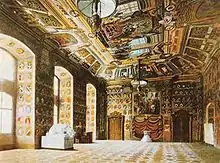
The marble floor in white, red, and black, the five-door frames, the door to the Hall of Arms, and the southern fireplace were all made by the Venetian Francesco Robba. The northern fireplace was reconstructed in 1908 by Pietro d'Aronco from Gemona. Since March 2006, the prince's stone has once again been placed in front of this fireplace.
 Fromiller and Sons as a self-perpetuation in the lower right corner of the ceiling fresco in the large coat of arms hall
Fromiller and Sons as a self-perpetuation in the lower right corner of the ceiling fresco in the large coat of arms hall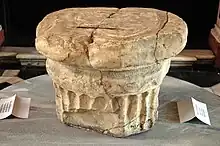 "Princely Stone" exhibited in the Great Hall of Coats of Arms (since 2006)
"Princely Stone" exhibited in the Great Hall of Coats of Arms (since 2006)
Small Hall of Coats of Arms
In the Small Hall of Arms, formerly called the Ratsstube (Council Chamber), the meetings of the Board of Deputies (forerunner of the state government) took place in the Estates Period. The room measures 10 × 6.5 meters and has two windows in deep niches on the north and south sides. The hall was designed by Fromiller in 1740. Here the walls show 298 coats of arms of the burgraves, general collectors, provincial presidents, councilors, and the last noble provincial governors of Carinthia. The flat ceiling shows mock architecture and an allegorical fresco Veritas temporis filia ("Truth as the Daughter of Time").
Boardroom
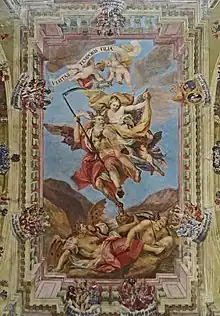
The meeting room, originally called the Landstube, was used as a meeting room from the beginning. The room comprises 4 × 2 window axes and measures around 18 × 9 meters. Since 1927, it has extended over two stories. Lobisser's frescoes from 1928 on the north wall, which are still preserved today, bear the following titles from left to right:
- "Auszug zum (Abwehr)Kampf" ("Exit for (defensive) combat")
- "Verbrüderung (Agitation)" ("Fraternity (Agitation)")
- "(Jubel nach der) Volksabstimmung“ ("(Cheering after the) referendum")
The frescoes painted by Lobisser in 1938 were covered in 1945. The east side was destroyed in 1970 when the visitors' gallery was built, and the other frescoes were removed in 2000.
They showed the following scenes:
- "Zeit der Illegalität“ ("Time of illegality"), on the east side: A mother with three children is standing in front of a prison wall.
- "Erwartung" ("Expectation") (of the connection), on the south wall, next to the previous picture: The picture shows a student with a swastika in the book, a mother holding up her child, and other people waiting.
- "Stunde der Befreiung" ("Hour of liberation"): a German and an Austrian soldier shake hands.
- "Die Botschaft auf dem Lande" ("The message in the country"): a cyclist waving a swastika flag brings the news of the connection to the farmers.
- "Illegaler Kämpfer" ("Illegal Combatant"), in the southwest corner: he has a bandaged head but is standing up.
- "Sozialismus der Tat" ("Socialism of action"), on the west side: A woman from the old Reich distributes gifts to Austrian children.
- "Treueschwur" ("Oath of allegiance"): Carinthians in traditional costume surround a Nazi national emblem with a German salute.
Koligsaal
The hall was originally 9 × 7 meters but was made smaller by the installation of sanitary facilities on the north side.
Anton Kolig designed the hall in 1929 and 1930 with his students, including Anton Mahringer, Karl Bertsch, and Karl Kraus. The paintings were destroyed in 1938. Only Kolig's sketches and black-and-white photos have survived to this day.[20] Otto Demus described the paintings in detail in 1930. Little is known about the frescoes' color scheme, but the room's ceiling frescoes' color scheme, but the room's ceiling was rust green, and the floor was brick red.[21]
- On the east wall: Youths, in whom Kolig's students can be identified, carry beams to build the workshop. A naked woman in the middle hands Anton Mahringer, who is standing with his back to the viewer, an egg as a gift of love and/or a symbol of fertility. The following picture is separated by the door: Anton Kolig is standing in front of a painting “Madonna and Child”. A student humbly hands him a bowl of paints.
- On the north wall was the Banquet, which was strongly based on the iconography of the Last Supper. Most of the characters can be identified. Among them are Kolig, Anton Mahringer, Josef Friedrich Perkonig and Alois Maier-Kaibitsch.
- On the west wall on the left were three boys singing in the open air. To the right of this, two lovers are crouching, one of the men is handing his lover a pearl necklace. Separated by a door is the maid's room: three women undress, one of whom is obviously pregnant. This motif shows echoes of the motifs of the Three Graces or the Judgment of Paris.
- On the south wall, the window wall, adjacent to the west wall, there was a Hessian peasant couple bending over an open children's coffin. A small child is sitting in front of it. This picture was a homage to the donor state of Hesse-Nassau. The central pillar showed a two-figure group "Looking up figure and floating genius" with the inscription: "Hessen-Nassau / Carinthia / Werkst. Kolig”. In the window jambs, there were four figures of soldiers who "guard" the room to the south, alluding to the Carinthian defensive struggle.
Cornelius Kolig combined elements of his grandfather with new elements in his design of the Kolig Hall in 1998. Anton Kolig's paintings Gastmahl ("Banquet"), Mägdekammer ("Chamber of Maids"), and the singers with the lovers were installed as large-scale, monochrome reproductions. In between are installations by Cornelius Kolig: Der Flieger ("The Aviator"), a black male torso that merges into a beam above the navel; a wall of red roses. The two doors on the west and east sides are sliding doors made of stainless steel. On the window side, the lettering "TAT" runs across the entire front; opposite, on the bronze-colored sliding door in front of the toilet, the small lettering "ORT".
Current usage
Today, the Landhaus Klagenfurt is the seat of the Carinthian Parliament, which meets regularly - usually on Thursdays - in the session hall. The Landtag parties have their offices in the historic rooms on the first and second floors.
The Large and Small Heraldic Halls as well as the Sitting Hall and the Colony Hall can be visited by guided tour during the summer months. Since 2003, the Landhaus Gallery has been located on the first floor.
The ground floor and parts of the cellar are now occupied by the restaurant Gasthaus im Landhaushof. In the cellar rooms, there was a dedicated cultural initiative Theater im Landhauskeller in the 1990s.
Literature
- Wilhelm Deuer, Das Landhaus zu Klagenfurt, Verlag des Kärntner Landesarchivs, Klagenfurt 1994, ISBN 3-900531-29-3
- Siegfried Hartwagner: Neuer Kaiser Verlag, Klagenfurt 1994.
- Erwin Hirtenfelder; Bertram Karl Steiner, Tatort Kolig-Saal. 1929–1999, Universitätsverlag Carinthia, Klagenfurt 1999, ISBN 3-85378-498-4
- Urban Paumgartner (2002), Aristeion Carinthiae Claudiforum, lagenfurt, der Ehrenpreis Kärntens. Hrsg.: Thomas Lederer. Kärntner Landesarchiv, Klagenfurt 2002, ISBN 3-900531-51-X
References
- ↑ Wilhelm Deuer (1994). Das Landhaus zu Klagenfurt. Verlag des Kärntner Landesarchivs, Klagenfurt 1994. p. 13. ISBN 3-900531-29-3.
- ↑ Wilhelm Deuer (1994). Das Landhaus zu Klagenfurt. Verlag des Kärntner Landesarchivs, Klagenfurt 1994. p. 18. ISBN 3-900531-29-3.
- ↑ Wilhelm Deuer (1994). Das Landhaus zu Klagenfurt. Verlag des Kärntner Landesarchivs, Klagenfurt 1994. pp. 21–22. ISBN 3-900531-29-3.
- ↑ Zitiert nach Herbert Stejskal (Hrsg.): Kärnten. Geschichte und Kultur in Bildern und Dokumenten. Universitätsverlag Carinthia, Klagenfurt 1999. p. 123.
- ↑ Wilhelm Deuer. Das Landhaus zu Klagenfurt. Verlag des Kärntner Landesarchivs, Klagenfurt 1994. p. 62. ISBN 3-900531-29-3.
- ↑ Wilhelm Deuer. Das Landhaus zu Klagenfurt. Verlag des Kärntner Landesarchivs, Klagenfurt 1994. p. 131. ISBN 3-900531-29-3.
- ↑ Erwin Hirtenfelder; Bertram Karl Steiner. Tatort Kolig-Saal. 1929–1999. Universitätsverlag Carinthia, Klagenfurt 1999. p. 25. ISBN 3-85378-498-4.
- ↑ Tatort Kolig-Saal. 1929–1999. Universitätsverlag Carinthia, Klagenfurt 1999. p. 27. ISBN 3-85378-498-4.
- ↑ Zitiert nach Josef Friedrich Perkonig in einem Brief Erwin Hirtenfelder, Bertram Karl Steiner: Tatort Kolig-Saal. 1929–1999. Universitätsverlag Carinthia, Klagenfurt 1999. p. 27. ISBN 3-85378-498-4.
- ↑ Zitiert nach Wilhelm Deuer: Das Landhaus zu Klagenfurt. Verlag des Kärntner Landesarchivs, Klagenfurt 1994. p. 143. ISBN 3-900531-29-3.
- ↑ Kärntner Grenzruf vom 5. November 1938, zitiert nach Erwin Hirtenfelder, Bertram Karl Steiner: Tatort Kolig-Saal. 1929–1999. Universitätsverlag Carinthia, Klagenfurt 1999. 1999. p. 47. ISBN 3-85378-498-4.
- ↑ Erwin Hirtenfelder; Bertram Karl Steiner (1999). Tatort Kolig-Saal. 1929–1999. Universitätsverlag Carinthia, Klagenfurt 1999. p. 61. ISBN 3-85378-498-4.
- ↑ Der Standard vom 27. Februar 1998, zitiert nach Erwin Hirtenfelder, Bertram Karl Steiner: Tatort Kolig-Saal. 1929–1999. Universitätsverlag Carinthia, Klagenfurt 1999. 1999. p. 66. ISBN 3-85378-498-4.
- ↑ Zitiert nach Erwin Hirtenfelder, Bertram Karl Steiner: Tatort Kolig-Saal. 1929–1999. Universitätsverlag Carinthia, Klagenfurt 1999. 1999. p. 70. ISBN 3-85378-498-4.
- ↑ Landeshauptmann Dr. Christof Zernatto (ÖVP), zitiert nach Erwin Hirtenfelder, Bertram Karl Steiner: Tatort Kolig-Saal. 1929–1999. Universitätsverlag Carinthia, Klagenfurt 1999. 1999. p. 88. ISBN 3-85378-498-4.
- ↑ Jörg Haider am 11. Juli 1998 in der Kronen Zeitung: "Die von Kolig geplante Ausgestaltung des Raumes verletzt zutiefst religiöse Gefühle und ist menschenverachtend." Er nannte sie eine "Art von Schweinerei, die man an als künstlerisch wertvolle Maßnahme verkaufen will." Zitiert nach Erwin Hirtenfelder, Bertram Karl Steiner: Tatort Kolig-Saal. 1929–1999. Universitätsverlag Carinthia, Klagenfurt 1999. 1999. p. 90. ISBN 3-85378-498-4.
- ↑ Erwin Hirtenfelder; Bertram Karl Steiner (1999). Tatort Kolig-Saal. 1929–1999. Universitätsverlag Carinthia, Klagenfurt 1999. p. 93. ISBN 3-85378-498-4.
- ↑ Wilhelm Deuer (1994). Das Landhaus zu Klagenfurt. Verlag des Kärntner Landesarchivs, Klagenfurt 1994. p. 171. ISBN 3-900531-29-3.
- ↑ "Coat-of-Arms Hall at the Klagenfurt Landhaus". Cultural Places. Retrieved 2023-05-16.
- ↑ Otto Demus. Die Gemälde Anton Koligs im Landhaus zu Klagenfurt. Österreichische Kunst 1 Jg. H. 11, Wien 1930. p. 29.
- ↑ Erwin Hirtenfelder; Bertram Karl Steiner. Tatort Kolig-Saal. 1929–1999. Universitätsverlag Carinthia, Klagenfurt 1999. pp. 16–19. ISBN 3-85378-498-4.